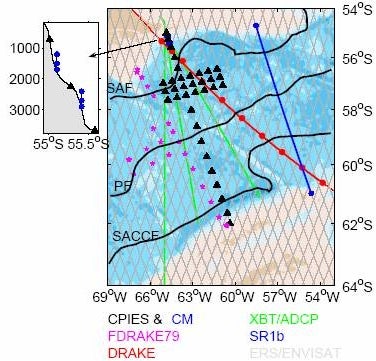Principal Investigators
- Teresa Chereskin, Scripps Institution of Oceanography, University of California, San Diego
- Kathleen Donohue, University of Rhode Island
- D. Randolph Watts, University of Rhode Island
Abstract
(Link to proposal)
The proposed work is a multi-year study of the transport of water through Drake Passage by the Antarctic Circumpolar Current (ACC). Drake Passage acts as a chokepoint that is not only well suited geographically for measuring the time-varying transport, but observations and computer models suggest that dynamical balances which control the transport are particularly effective here. An array of Current Meters and Pressure-recording Inverted Echo Sounders (CPIES) will be set out in November 2007 from the R/V Nathaniel B. Palmer for a period of 4 years to quantify the transport and dynamics of the Antarctic Circumpolar Current. Data will be collected annually by acoustic telemetry, leaving the instruments undisturbed until recovered at the end of the project.
The Southern Ocean is believed to be especially sensitive to climate change, responding to winds that have increased over the past thirty years, and warming significantly more than the global ocean over the past fifty years. The proposed observations will resolve the seasonal and interannual variability of the total ACC transport, as well as its vertical and lateral structure. Although not submitted specifically to the International Polar Year (IPY) Program Solicitation, the proposed project contributes to the IPY goal of understanding environmental change in polar regions and represents a pulse of activity in the IPY time frame that will extend the legacy of the IPY. The data and findings will be reported to publicly accessible archives and submitted for publication in the scientific literature. It is a scientific collaboration between the University of California, San Diego, and the University of Rhode Island.
Proposed array of CPIES (black diamonds) and current meters (blue circles) which will measure the ACC across Drake Passage and map the circulation and eddy currents within a local dynamics array. The cross-passage array is coincident with an ENVISAT track (grey lines) and lies east of FDRAKE79 current meter moorings (magenta stars) and beneath the LMG repeat ADCP/XBT transects (green lines). Nearby observational programs include the DRAKE Mooring Line, PI C. Provost (red), SR1b repeat hydrographic section (blue line) and bottom pressure recorders (blue circles at terminations of SR1b). The inset to left of the map illustrates the configuration of two deep current meters moorings (blue circles) above the northern continental slope. Each mooring has current meters 100, 300 and 600 meters off the bottom. ACC frontal locations (bold black lines) (Orsi et al., 1995) are closely tied to bathymetry from Smith and Sandwell (1997) (contoured every 1000 m depth; tan hues represent shallow depths transition to blue hues in the deeper parts of the passage).
Listing of proposed instrument locations.
Selected Publications
- Chereskin, T. K., K. A. Donohue, and D. R. Watts. cDrake: Dynamics and transport of the Antarctic Circumpolar Current in Drake Passage. Oceanography, 25(3):134–135, 2012. (doi:10.5670/oceanog.2012.86)
- Chereskin, T. K., K. A. Donohue, D. R. Watts, K. L. Tracey, Y. Firing, and A. L. Cutting. Strong bottom currents and cyclonesis in Drake Passage. Geophys. Res. Lett., 36(L23602), 2009. (doi:10.1029/2009GL040940)
- Donohue, K. A., K. L. Tracey, D. R. Watts, M. P. Chidichimo, and T. K. Chereskin. Mean Antarctic Circumpolar Current transport measured in Drake Passage. Geophysical Research Letters, 43(22):11,760–11,767, 2016. (doi:10.1002/2016GL070319)
- Watts, D. R., M. A. Kennelly, K. A. Donohue, K. L. Tracey, T. K. Chereskin, R. A. Weller, and I. Victoria. Four current meter models compared in strong currents in Drake Passage. J. Atmos. and Oceanic Tech., 2013. (doi:10.1175/JTECH-D-13-00032.1)
This project is funded by the National Science Foundation under Grant No. 0635437.
Disclaimer: Any opinions, findings and conclusions or recommendations expressed in this material are those of the author(s) and do not necessarily reflect the views of the National Science Foundation (NSF).

